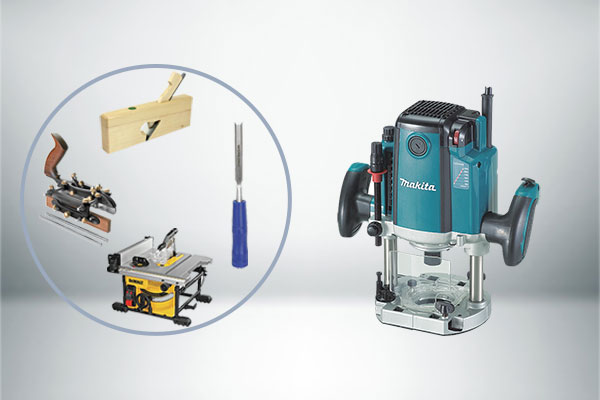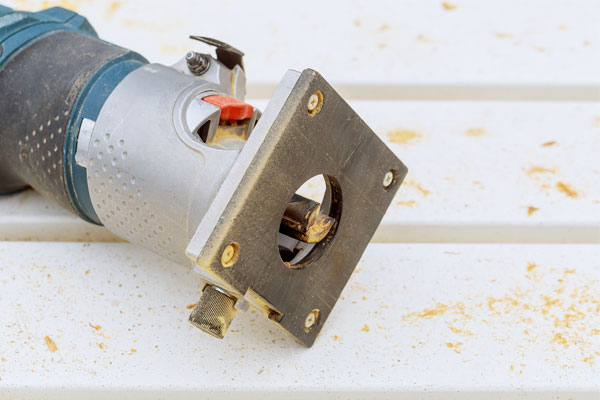Router Table Guide: What Is a Router Table and Its Uses?
A router table is a piece of classic woodworking machinery that mounts a router onto a table. While one of the most popular features of a router is its portability, using the freehand varients limits you immensely on specific cuts.
The stationary nature opens up options to cut on certain angles with complete precision. It’s an essential tool for anyone who wants to make cuts into smaller pieces of wood. However, before you get one, you must know the basics of what a router table is and why you will need them in the first place.
What Is a Router Table?

The tool uses a universal motor. It’s powerful in terms of how many rotations it can dish out in a minute. A variable router has a speed that ranges from about 12,000 RPM to 20,000 RPM. On top of that, these are also quite versatile as they are portable.
A router table is a means to which you can mount your router. You have to install it upside down, and that gives you a platform to adjust and position your wood correctly. As such, you have incredible control over how you want to make your cuts. You’ll be able to attain cuts that wouldn’t be able to with a portable router.
However, that doesn’t mean that the portability is completely gone. You can simply take out the router from your table for handheld use whenever you want. As such, you have plenty of options and flexibility when it comes to getting a router table.
Everything about the router relies on its spinning tool. It’s the component that spins at high speeds to make the cuts. The main characteristic of router spindles is that they are quite small. That is because a router is more geared towards small bits than larger ones.
So, if you’re looking for something for cutting larger wood, then you should go for something different like a shaper. Nevertheless, when it comes to making cuts on small bits, nothing will give you more accuracy and precision than a pristine router table.
Types of Router Table
Now that you know what one of these tools is in general, you should know the two main different types of Router Tables that are out in the market right now. Each specializes in different qualities, so it’s best you know what each of them does if you plan on getting one for yourself.
-
Free Standing Tables

Yes, rather than placing it on a bench, it comes with legs that make it a standalone table. However, if you want to convert it into a benchtop table, you can. A lot of these types of router tables give you the option to take out the legs. As a result, they become the other type of table.
-
Benchtop Tables

While that might seem somewhat limiting, it actually adds to its utility. You can freely take it out of your bench and put it anywhere else you want or need. This adds to its utility and flexibility. Although it cuts down on space due to its smaller stature, it makes up for it through its added portability.
Common Uses for a Router Table
So, now that you know what they are, let’s get acquainted with its many uses. You’ll be delighted to know the number of uses for one of these tools is immeasurable. There are a lot of applications if you’re creative enough. Nevertheless, here are some of the most common uses for these tables.
-
To Cut Slender Materials

Imagine how rough it would be to cut long pieces of wood with a handheld router. You’d hardly get the cut you want. With the addition of a table, you’re now able to make precision cuts in the directions you want without the handling issues long materials are bound to have.
-
Create Pattern Work

Since the router allows you to make intricate precision cuts, you’ll get to get creative with designs. With careful and precise use, you can create an endless amount of patterns.
-
Maintain Consistency

One of the things we love about router tables is their ability to maintain consistency. It opens up scope for symmetry and let’s maintain quality control. As a result, furniture building becomes a treat.
-
Make Slots for Connecting
The router’s incredible cutting prowess makes connecting pieces a treat. You get to create grooves and slots that join together perfectly. Subsequently, your crafts become easy to assemble.
-
Create Dowels

Sick of the stereotypical blocky shape wood takes? With the right use of a router table, you can make state-of-the-art dowels for whatever project you undergo.
-
Craft New Shapes
Routers aren’t limited to any specific number of shapes. If you know how to use it, you can use wood like clay and mold it into any shape you desire.

We haven’t even begun talking about all of the plethoras of uses a Router table has. Nevertheless, it should give you an idea about the many ways you use it for your projects!
How to Use a Router Table – Step by Step Guide
Now that you know what they are used for, you need to know how to use them. Follow this step by step guide, and you should have an idea of how they work.
-
Set Everything up
Preparations always come first. Make sure you mount the router properly onto the table. Grab the materials you need and keep it close. Make sure the table is properly clamped onto a surface, so it doesn’t wobble during use. You should always use hearing and eye protection no matter how safe you think the router is.
-
Positioning the Wood
The next step is actually to position the wood. Adjust the wall to the position you need and hold the wood down along it. Be gentle enough not to harm the piece, but also be hard enough so that it stays still.
-
Turn on the Router and Run the Wood Along
Now that everything is in position, turn on the router, so we can get started. Run the wood along the turned-on router to make whatever shape you need. Since you’re using a table, you’ll need to move from right to left. This is because the bit is inverted on the table. Make sure you make even cuts, and you’re good to go.
Different Projects It Can Do
The router’s unique bits and high RPM makes it usable for a wide variety of projects. So, here’s a rundown on some notable ones
Edge Routing
A router table is ideal for edge-routing tasks, such as creating decorative edges on boards, chamfering edges, or rounding over corners. The table provides a stable platform for guiding the workpiece along the router bit, resulting in consistent and uniform edge profiles.
Rabbets and Dadoes
With a router table, you can easily create rabbets and dadoes, which are commonly used in joinery and woodworking projects. By adjusting the height and fence position, you can accurately control the width and depth of the cuts, allowing for precise and clean results.
Mortises and Tenons
Using a router table with a mortising attachment or a specialized router table jig, you can efficiently create mortises for joinery purposes. This enables the construction of strong and secure joints, such as mortise and tenon joints, which are commonly used in furniture making and cabinetry.
Box Joints and Dovetails
Router tables equipped with dovetail jigs or box joint jigs enable the creation of intricate joinery, including box joints and dovetail joints. These joints are popular for their strength, aesthetic appeal, and suitability for drawers, boxes, and casework.
Raised Panels and Door Frames
A router table with a panel raising bit allows you to shape and create raised panels for cabinet doors and furniture. The table provides stability and control, ensuring accurate and consistent results while shaping the panels or constructing door frames.
Slot Cutting and Grooving
Router tables are excellent for cutting slots and grooves in various materials. Whether you need to create grooves for inserting splines, cut slots for hardware or sliding mechanisms, or make channels for inlays, the router table provides a stable and controlled environment for precise routing.
Router Table Fences
In addition to the various routing operations, router table fences offer versatility and support for tasks such as coping and shaping the edges of rails and stiles for door frames, producing consistent edge profiles, or guiding workpieces for accurate and repeatable cuts.
Wooden Frame
The ability to join makes this an ideal tool to make wooden frames. While this is an easier project, it’s a great way to get started.
Bed Legs
Your ability to make exquisite dowels is perfect for making bed legs. There are a ton of creative ways to design the legs in a lot of creative ways.
Doll House
The high rotations allow you to condition your materials perfectly to make a dollhouse.
Coin Box
You can make a lot of creative design choices when it comes to making boxes. Add a coin hole on top, and you got an excellent coin box.
There are a lot more projects you can do. You are only limited by your creativity and ingenuity. Just make sure you plan everything out first. So, get creative and make whatever you can dream of!
Conclusion
Now that you’re aware of what a router table is, what they’re for and how to use them, you should be ready to get to work. So, route and bring your dreams to life!
Table of Contents





